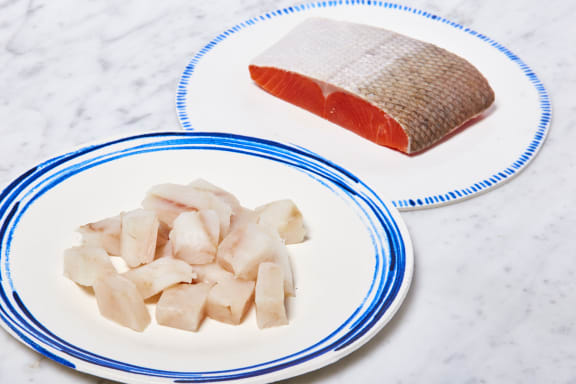Want the lowdown on what is the healthiest fish to eat? We’ve got you covered with a list of healthy fish to eat, depending on a wide range of criteria that highlights all the good stuff that wild-caught seafood from Alaska has to offer. Whether you’re looking for a tasty dose of omega-3s, a fish that’s safe for expectant mothers, or a delicious low-calorie/high-protein treat to keep you in tip-top shape, there’s a wide range of healthy fish to eat from Alaska.
Here are some of the best options for you:
When You Want Fish High in Omega-3 Fatty Acids
Healthiest Fish: It’s a tie between wild Alaskan coho salmon and sablefish.
When you’re looking for the healthiest fish to eat based on its omega-3 fatty acid content, a 6-ounce fillet of either coho salmon or sablefish contains about 2500mg of these heart-healthy, anti-inflammatory, brain-boosting fats. These species of fish are two of the richest sources of omega-3s in Alaska.
Culinarily, they couldn’t be more different. Coho has a subtle salmon flavor, a fillet that cooks up with a lean and flaky texture. Sablefish, on the other hand, has a buttery mouthfeel and flakes up into large, delicate pieces. Enjoying both of these two varieties of wild Alaskan fish on a regular basis will keep you on top of your omega-3 intake while giving you a variety of meal options to play with. Our recipe for roasted sablefish with a squash succotash is the perfect fall dish, while coho is a great option to use in salmon recipes that call for gentle cooking methods.
Honorable Mention: Sockeye salmon, which contains 2000mg of omega-3 fatty acids.
When You Want Fish Low in Mercury
Healthiest Fish: It’s a tie between any variety of wild Alaksan salmon and wild Alaska pollock.
Wild Alaskan salmon (both coho and sockeye) and wild Alaska pollock all contain low enough levels of mercury contamination that experts across the board encourage you to choose these species (among many others!) when you want to enjoy fish on a regular basis, with no restrictions on how much you should eat.
Mercury contamination in seafood usually becomes more significant of an issue in larger fish, as it is a neurotoxin that bioaccumulates as it travels up the food chain from polluted waters to large predatory species like big eye tuna, swordfish, and king mackerel. Wild salmon and pollock, being smaller and relatively low in the marine food chain, are safe to eat even if you’re watching your mercury intake.
Honorable Mention: Pacific cod is a relatively large species of fish compared to salmon and pollock, so they do contain moderate mercury levels that you’ll need to keep an eye on if you’re pregnant, planning to become pregnant, or need to watch your mercury intake. Otherwise, enjoy up to 6 servings of Pacific cod each month with no worries, according to figures gathered by the NRDC.
When You Want the Leanest Fish
Healthiest Fish: Wild Alaskan Cod
When you’re counting calories to keep things in balance or as part of a calorie restrictive diet, you can count on cod. With just over 150 calories per each 6-ounce serving, 32 grams of clean protein, and under 1 gram of fat, cod is the leanest of the Alaskan bunch.
Don’t be mistaken though — just because it’s lean doesn’t mean it’s bland. Though cod is mild in flavor, it can stand on its own with a drizzle of olive oil, handful of herbs or dose of spices, and light sprinkling of salt — meaning, you don’t need to use heavy sauces or batters to enjoy cod (unless you want to, that is). That means you can enjoy cod for a variety of lean, tasty meals throughout the week.
Honorable Mention: wild Alaska Pollock is just a smidge less lean, containing just 2 grams of fat and 180 calories for each 6-ounce serving.
When You Want the Most Sustainable Fish
Healthiest Fish: All Alaskan fish!
Okay, so this was sort of a trick category. But in our humble opinion, we need to consider how our fish consumption affects the health of the planet. And it turns out that all Alaskan species are healthy fish to eat, in this context.
Alaska is so serious about protecting its wild fisheries that sustainability is written into the state constitution. Finite resources like regional flora and fauna are protected under the Alaskan constitution in order to safeguard the ecosystem in which its wild seafood industry thrives. Alaskan fishermen and agencies are also avid stewards of the industry, hewing closely to quotas that prevent overfishing and complying with restrictions that minimize the impact that the fishing industry has on marine habitats.
Because of these unique fishing practices that are designed to allow a manmade industry to flourish while respecting the balance and abundance of nature, Alaska’s wild fisheries have the reputation as the gold standard when it comes to sustainability.
Honorable Mention: Did we mention wild Alaskan shellfish like scallops, crabs, and spot prawns are also some of the healthiest, tastiest and most sustainable options in the sea?






